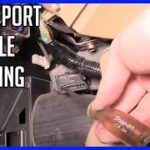The P0128 OBD-II trouble code indicates that your car’s engine coolant temperature hasn’t reached the required operating temperature within a specific timeframe. This can impact emissions, fuel efficiency, and potentially prevent an OBD2 test from completing successfully. Let’s explore how a P0128 code can affect your OBD2 test and what you can do about it.
How P0128 Affects OBD2 Tests
Your car’s onboard diagnostic system (OBD-II) constantly monitors various systems to ensure they’re functioning correctly. Before an OBD2 test can complete, certain readiness monitors need to run and report their status. These monitors verify emissions-related components are working as designed.
The P0128 code, signaling a potential problem with the cooling system, can prevent these monitors from running. A consistently low engine temperature prevents the catalytic converter from reaching its optimal operating temperature, hindering its ability to effectively reduce harmful emissions. Because of this, the OBD2 system might postpone or prevent the completion of the emissions-related monitors, leading to an incomplete OBD2 test. In many jurisdictions, you cannot pass your emissions test with an incomplete OBD2 scan.
Common Causes of P0128
The most common culprit behind the P0128 code is a malfunctioning thermostat.
-
Stuck Open Thermostat: A thermostat stuck in the open position allows coolant to constantly circulate through the engine, preventing it from reaching its optimal operating temperature. This continuous flow keeps the engine cooler than it should be, triggering the P0128 code and potentially obstructing the completion of OBD2 tests.
-
Faulty Engine Coolant Temperature (ECT) Sensor: The ECT sensor provides the engine control module (ECM) with crucial temperature readings. A faulty sensor can send inaccurate information to the ECM, leading to a P0128 code even if the thermostat is functioning properly. Incorrect data can also prevent the OBD2 system from completing its tests.
-
Wiring Issues: Damaged or corroded wiring connected to the ECT sensor can also disrupt the signal, leading to similar issues as a faulty sensor.
Diagnosing and Fixing P0128
Resolving the P0128 code is crucial for passing your OBD2 test. Here’s a breakdown of diagnostic steps:
-
Check Engine Heat: If your car’s heater isn’t producing sufficient heat, it’s a strong indicator of a cooling system problem, likely a stuck open thermostat.
-
Inspect the Thermostat Housing: Carefully feel the upper radiator hose connected to the thermostat housing after the engine has been running for a few minutes. If it’s cold, the thermostat might be stuck open. Caution: Be mindful of moving parts like the fan and belts.
-
Use an OBD2 Scanner: A quality OBD2 scanner with live data capabilities can display the engine coolant temperature reading. Compare this reading to the manufacturer’s specifications to determine if the engine is reaching its proper operating temperature. This tool is also crucial for checking and clearing any trouble codes.
-
Test the ECT Sensor: A multimeter can be used to test the resistance of the ECT sensor and compare it to the manufacturer’s specifications.
Conclusion
A P0128 code can indeed prevent an OBD2 test from completing due to its impact on emissions-related readiness monitors. Addressing the underlying cause, typically a faulty thermostat or ECT sensor, is essential to ensure a successful OBD2 test and maintain the overall health of your vehicle. Don’t delay in diagnosing and fixing this issue to avoid further complications and ensure your car is running efficiently.

